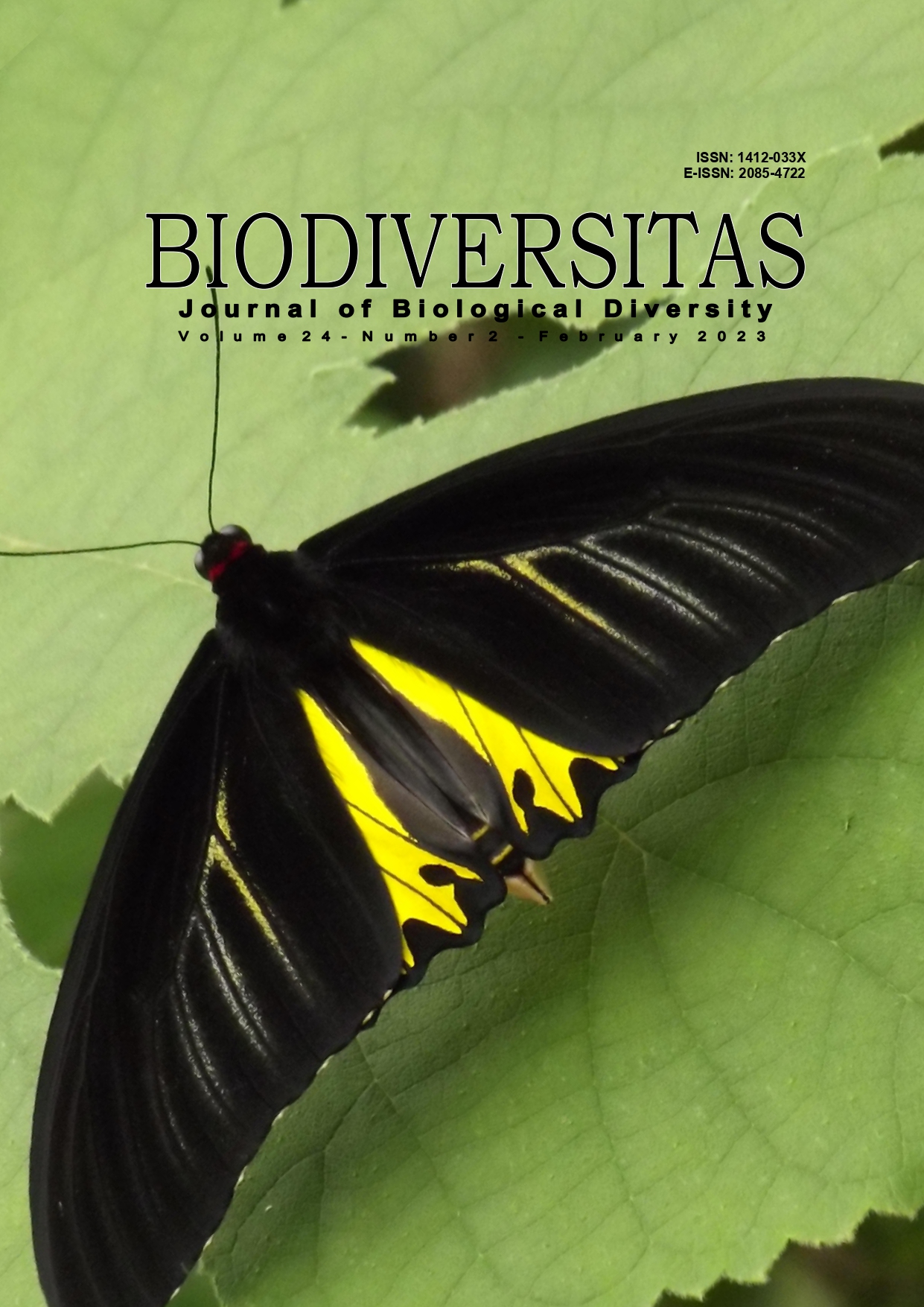Inhibitor a-glucosidase activity of Pediococcus acidilactici DNH16 isolated from Dali ni Horbo, a traditional food from North Sumatra, Indonesia
##plugins.themes.bootstrap3.article.main##
Abstract
Abstract. Fachrial E, Anggraini S, Harmileni, Saryono, Nugroho TT. 2023. Inhibitor a-glucosidase activity of Pediococcus acidilactici DNH16 isolated from Dali ni Hhorbo, a traditional food from North Sumatra, Indonesia. Biodiversitas 24: 958-965. Traditional foods, specifically those made from milk, are a potential source of probiotics. These components positively impact digestion and inhibit ?-glucosidase, implying that they can be used as supplements for type 2 diabetes patients. Therefore, this study aims to isolate and identify probiotics from Dali ni Horbo, which have a-glucosidase inhibitory activity. Lactic Acid Bacteria (LAB) isolates from Dali ni Horbo were characterized morphologically and biochemically using Gram staining, Catalase test, and type of fermentation. They were further analyzed for their probiotic properties, namely antimicrobial activity, using agar diffusion, acid resistance, and bile salt with a spectrophotometer. Isolates that showed the highest antimicrobial activity, acid resistance, and bile salt were then further analyzed for their ?-glucosidase inhibitor activity. The samples were then identified molecularly using PCR amplifying the 16S rRNA gene. The PCR products were sequenced and submitted to the NCBI GenBank to determine the homology of the microorganism. The results showed that 1 out of 23 isolates, namely DNH16, had the highest antimicrobial activity against Staphylococcus aureus with an inhibition zone of 4.6 mm. It also has a high tolerance to acidic environments and bile salt, indicated by the percentage growth of 91.6% and 66.5% in an MRS medium containing 0.3% bile salt with a pH of 3. DNH16 isolate showed a-glucosidase inhibitor activity of 27% and was identified as Pediococcus acidilactici. The results show DNH16 has the potential to be used as a probiotic as well as an a-glucosidase inhibitor.
##plugins.themes.bootstrap3.article.details##
Most read articles by the same author(s)
- EDY FACHRIAL, VISENSIUS KRISDIANILO, HARMILENI, I NYOMAN EHRICH LISTER, TITANIA T. NUGROHO, SARYONO, Isolation, characterization, activity test and molecular identification of thermophilic bacteria producing proteases from Dolok Tinggi Raja Natural Hot Springs, North Sumatra, Indonesia , Biodiversitas Journal of Biological Diversity: Vol. 22 No. 4 (2021)
- AULIA ARDHI, KARINA CUCHA AHMAD, HANITA NOVRIANTI, ERA YURISA HUSNA, MARDI YULIS, NOVA WAHYU PRATIWI, SARYONO SARYONO, Hydrolytic enzymes-producing ability of species of actinomycetes and bacteria associated with wilted banana plants (Musa sp.) , Biodiversitas Journal of Biological Diversity: Vol. 20 No. 4 (2019)
- EDY FACHRIAL, RADEN RORO JENNY SATYO PUTRI, I NYOMAN EHRICH LISTER, SARI ANGGRAINI, HARMILENI, TITANIA T. NUGROHO, SARYONO, Molecular identification of cellulase and protease producing Bacillus tequilensis UTMSA14 isolated from the geothermal hot spring in Lau Sidebuk Debuk, North Sumatra, Indonesia , Biodiversitas Journal of Biological Diversity: Vol. 21 No. 10 (2020)
- RIRYN NOVIANTY, ANNISA HIDAYAH, SARYONO, AMIR AWALUDDIN, NOVA WAHYU PRATIWI, ANNISA HIDAYAH, ERIWINA JULIANTARI, The diversity of fungi consortium isolated from polluted soil for degrading petroleum hydrocarbon , Biodiversitas Journal of Biological Diversity: Vol. 22 No. 11 (2021)
- SARYONO SARYONO, SENJAVI RAKHMANA, FITRI RAHAYU, AULIA ARDHI, RUSLI RUSLI, NOVA WAHYU PRATIWI, TITANIA T. NUGROHO, Molecular identification of endophytic fungi isolated from the tuber of Dahlia variabilis and exploration of their ability in producing ß-galactosidase , Biodiversitas Journal of Biological Diversity: Vol. 18 No. 1 (2017)
- SARYONO, RIRYN NOVIANTY, NABELLA SURAYA, FINNA PISKA, SILVERA DEVI, NOVA WAHYU PRATIWI, AULIA ARDHI, Molecular identification of cellulase-producing thermophilic fungi isolated from Sungai Pinang hot spring, Riau Province, Indonesia , Biodiversitas Journal of Biological Diversity: Vol. 23 No. 3 (2022)
- SARYONO, ISMAWATI, NOVA WAHYU PRATIWI, SILVERA DEVI, MERRY YOHANA SIPAYUNG, NABELLA SURAYA, Isolation and identification of lactic acid bacteria from traditional food sarobuong of Kuantan Singingi District, Riau, Indonesia , Biodiversitas Journal of Biological Diversity: Vol. 24 No. 4 (2023)
- CHRISMIS NOVALINDA GINTING, FINNA PISKA, HARMILENI, EDY FACHRIAL, Molecular identification of thermophilic bacteria with antimicrobial activity isolated from hot springs in North Sumatra, Indonesia , Biodiversitas Journal of Biological Diversity: Vol. 24 No. 2 (2023)

